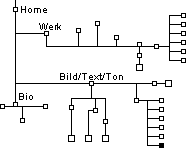|
|
Anna Oppermann: Ensemble -- Umfang (Ausdehnen und Zusammenziehen) -- das relative Einzelstück
 I. in Katalog: Zorn und Zärtlichkeit, Zürich 1980, o. S. (auch in Katalog: Junge Kunst in Deutschland - privat gefördert, Berlin 1982, S. 181; der Abschnitt "Umfang (Ausdehnen und Zusammenziehen) -- das relative Einzelstück" auch abgedruckt in Katalog: Anna Oppermann Ensembles 1968-1984, Hamburg und Brüssel 1984, S.47) I. in Katalog: Zorn und Zärtlichkeit, Zürich 1980, o. S. (auch in Katalog: Junge Kunst in Deutschland - privat gefördert, Berlin 1982, S. 181; der Abschnitt "Umfang (Ausdehnen und Zusammenziehen) -- das relative Einzelstück" auch abgedruckt in Katalog: Anna Oppermann Ensembles 1968-1984, Hamburg und Brüssel 1984, S.47)
 II. partial English translation in the catalog: Continuous Creation, Arts Council of Great Britain, London 1981, o. S., remaining text translated by Marie Oamek II. partial English translation in the catalog: Continuous Creation, Arts Council of Great Britain, London 1981, o. S., remaining text translated by Marie Oamek
 III. Traduction française dans le catalogue: Art Allemagne Aujourd'hui, Paris 1981, pp. 170-173 III. Traduction française dans le catalogue: Art Allemagne Aujourd'hui, Paris 1981, pp. 170-173 |
|
